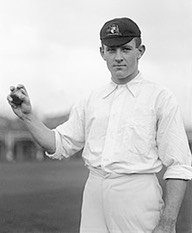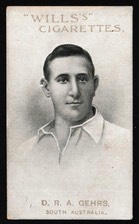Albert John Young "Bert" Hopkins (3 May 1874 – 25 April 1931) was an Australian cricketer and Penrith bee-farmer who played in 20 Tests between 1902 and 1909. An all-rounder, Hopkins was a competent bowler and batsman in Australian domestic cricket for New South Wales, however he was less frequently called on to bowl in Test matches.
In the second Test at Lord's in 1902, under captain Joe Darling, Hopkins opened the bowling for Australia with Ernie Jones. Hopkins took the first two wickets of the English team, the famed batsmen C. B. Fry and Ranjitsinhji, both for ducks. These were the only two wickets that fell in the match, which was abandoned not long afterwards owing to persistent rain.
He worked in the Probate Office of New South Wales for more than 25 years. He died in hospital in April 1931 after a short illness, 8 days before his 57th birthday.
Albert "Tibby" Cotter (3 December 1883 – 31 October 1917) was an Australian cricketer who played in 21 Test matches between 1904 and 1912. Although only 5'8" /173 cm tall (the same height as Harold Larwood), he was arguably the best fast bowler through the first decade of the 20th century. He had a reputation for breaking stumps and acquired the nickname “Terror Cotter” from English fans.
He served in World War I with the First Australian Imperial Force and was killed in action in the mounted charge of the 4th Light Horse Brigade at Beersheba in Ottoman Palestine.
Donald Raeburn Algernon “Algy” Gehrs (29 November 1880 – 25 June 1953) was an Australian cricketer who played in 6 Tests as batsman, leg break bowler and wicketkeeper.
He was the only representative of Port Adelaide Cricket Club in South Australia to play Test cricket for Australia (including against England in England in 1905).




